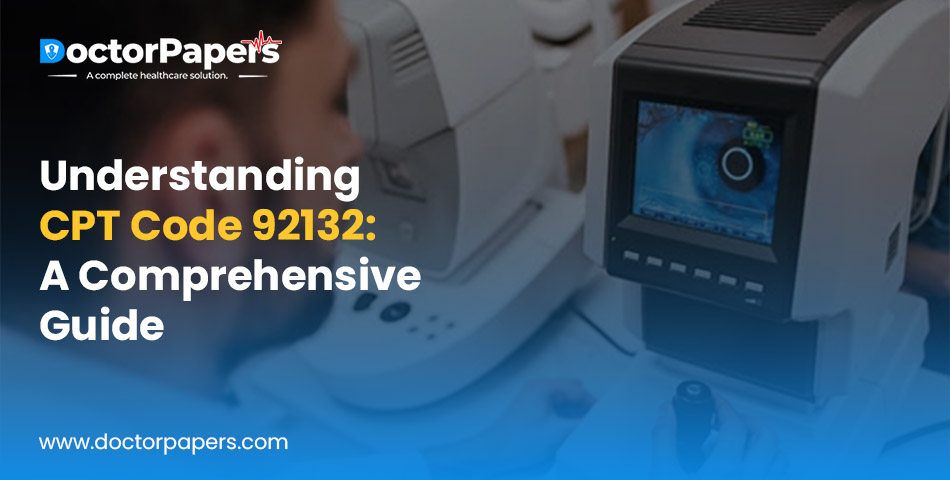Understanding CPT Code 92132: A Comprehensive Guide

Key Pointers: Understanding the procedure and its indications. Properly documenting the medical necessity and findings. Applying the correct billing codes and modifiers. Staying informed about payer-specific guidelines and frequency limitations. Importance in Medical Billing and Coding What is CPT Code 92132? Indications for Use Billing and Reimbursement Coding Guidelines Case Studies and Examples Troubleshooting Common Issues Medical billing and coding play a crucial role in the healthcare industry, ensuring that healthcare providers are accurately compensated for their services. One such code that requires attention is CPT Code 92132. This code refers to Scanning Computerized Ophthalmic Diagnostic Imaging (SCODI) of the anterior segment of the eye. This code is primarily used for diagnostic imaging that helps assess various eye conditions. This code is essential for medical coders and billers, as it directly impacts reimbursement and patient care. Importance in Medical Billing and Coding Exact coding guarantees that medical care suppliers are repaid for their services. Mistaken use of CPT Code 92132 can prompt case refusals, installment deferrals, or underpayments. By mastering the complexities of this code, clinical billers, and coders can avoid normal traps and upgrade the charging system. What is CPT Code 92132? CPT Code 92132 is explicitly intended for painless imaging systems to analyze the eye’s front portion. This imaging is essential in diagnosing glaucoma, corneal problems, and front uveitis. The method includes utilizing trend-setting innovation to capture nitty-gritty pictures of the eye’s front piece, supporting exact analysis and treatment planning. Procedure Details The procedure covered under CPT 92132 involves a detailed scan of the eye’s anterior segment using optical coherence tomography (OCT) or similar technology. This scan helps ophthalmologists assess structural abnormalities, measure intraocular pressure, and evaluate other critical parameters essential for effective treatment. Applicable Conditions and Diagnoses CPT Code 92132 diagnoses various eye conditions, including glaucoma, keratoconus, corneal dystrophies, and anterior uveitis. The code is primarily used when a thorough examination of the eye’s anterior segment is required to determine the appropriate course of treatment. Indications for Use Clinical Scenarios Requiring CPT 92132 This code is used in clinical scenarios requiring detailed segment imaging. For example, patients showing early signs of glaucoma or those with corneal abnormalities may require this diagnostic procedure. It is also used for pre-surgical evaluations and post-operative follow-ups. Patient Eligibility Criteria Not all patients will require a CPT 92132 procedure. Eligibility is typically determined based on the presence of specific symptoms or conditions that necessitate detailed imaging. The patient’s medical history, current symptoms, and previous diagnostic results are considered before deciding to use this procedure. Billing and Reimbursement How to Bill CPT Code 92132? While charging for CPT Code 92132, it is critical to guarantee that the documentation is intensive and precise. The charging system includes submitting claims with the proper conclusion codes to legitimize the methodology requirement. Observing the payer’s rules is vital to avoid guarantee refusals. Documentation Requirements Appropriate documentation is vital to fruitful charging. The medical care supplier should archive the patient’s side effects, the need for imaging, the discoveries from the technique, and the ensuing therapy plan. Deficient documentation can prompt case dismissals or reviews. Common Mistakes to Avoid in Billing The most widely recognized botch in charging CPT 92132 is the lack of documentation to legitimize the methodology. Other mistakes incorporate utilizing wrong analysis codes or not adhering to recurrence restrictions set by the insurance agency. These missteps can result in denied asserts or decreased repayments. Insurance Considerations Insurance agencies might have explicit rules and necessities for charging CPT Code 92132. Checking with the payer before submitting cases is fundamental to guarantee consistency with their strategies. A few guarantors might expect earlier approval, while others might have recurrence limits on how frequently the methodology can be charged. Coding Guidelines CPT Code 92132 vs. Similar Codes CPT Code 92132 is often confused with similar codes, such as 92133 and 92134, which are used for imaging the retina and optic nerve. Understanding the differences between these codes is essential to ensure accurate billing. Using the wrong code can lead to claim denials and potential audits. Modifiers and Their Proper Usage Modifiers play a significant role in medical billing, providing additional information about the procedure. For CPT Code 92132, appropriate modifiers should be used to indicate whether the procedure was bilateral or unilateral. Please use the correct modifiers to avoid incorrect payments. Frequency Limitations and Restrictions Insurance companies often impose frequency limitations on how usually CPT Code 92132 can be billed for the same patient. Understanding these restrictions is crucial to avoid denied claims. Additional imaging is an essential need. By adhering to these guidelines, healthcare providers can ensure that their claims are processed smoothly and that they receive appropriate reimbursement. Case Studies and Examples Real-World Application of CPT 92132 One should conduct a couple of contextual investigations to more readily comprehend the viable utilization of CPT Code 92132. For instance, consider a patient determined to have early-phase glaucoma. The ophthalmologist arranges a front-fragment OCT to evaluate the point of the foremost chamber. The sweep decides the degree of the infection, permitting the doctor to decide on the proper treatment, like medicine or medical procedure. The exact coding of this system utilizing CPT 92132 guarantees that the supplier is repaid for the essential symptomatic assistance. Example Scenarios with Coding Solutions In another situation, a patient presents with side effects of corneal dystrophy. The ophthalmologist utilizes the foremost section of OCT imaging to assess the corneal layers and identify anomalies. For this situation, CPT 92132 and the proper determination code for corneal dystrophy are used for charging. The documentation should justify the imaging and the discoveries to help the case. This approach helps avoid potential claim rejections. Troubleshooting Common Issues Medical billing for CPT Code 92132 can sometimes be challenging due to various issues, such as claim denials or requests for additional documentation. Here are some common problems and solutions: Claim Denials Due to Lack of Medical Necessity: To avoid this, ensure that the documentation justifies the necessary imaging. This

